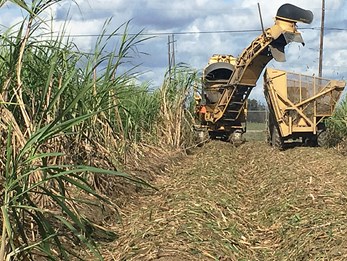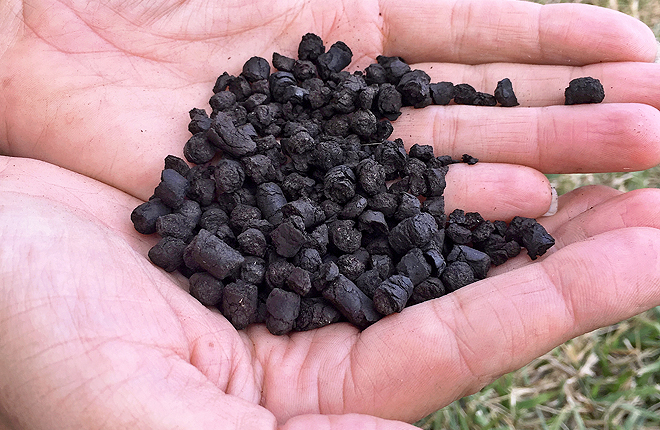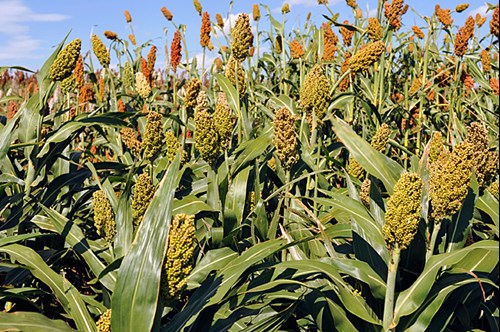Adding Value to Sugar Crop Trash & Byproducts
The old adage “one man’s trash is another man’s treasure” can be taken literally when it comes to residual material from sugar crops such as sugarcane, sweet sorghum, and sugar beets.
These crops provide sugars, molasses, syrups, and other products to sweeten our foods. But during harvest and after sugar extraction, a lot of solid plant material is left over.
Louisiana leads U.S. sugarcane production—growing 400,000 acres or 48 percent of total U.S. acreage—and it produced 43 percent of U.S. cane sugar in 2016. Before harvest, farmers burn their fields to remove leaves, known as trash, from the stalks and make the crop easier to harvest. While some leafy trash goes back onto fields to help return nutrients to the soil, the practice of burning has been under scrutiny recently due to urban encroachment and air-quality concerns.
Another problem is bagasse, the fibrous matter left after crushing the sugarcane to extract the juice. A few mountains of excess bagasse—30 or 40 feet high—have accumulated over decades, towering outside of factories. Waste particles from these piles of bagasse become airborne in windy conditions, affecting air quality, says Isabel Lima, a chemist at the Agricultural Research Service’s (ARS) Southern Regional Research Center (SRRC) in New Orleans, Louisiana. Bagasse also occupies several acres per site, which is a waste of valuable land—as well as an eyesore.
Enhancing sugar crop value for farmers is one goal of SRRC scientists. They develop commercially viable technologies that boost growth and profitability, converting crops into sugar, biofuel, and bioproducts and improving postharvest quality and processing.
Making Bagasse into Biochar
 ARS scientists are finding uses for the solid plant waste that remains after sugarcane harvest and sugar extraction. (Isabel Lima, D3930-1) |
Recent work of SRRC’s Commodity Utilization Research Unit includes transforming sugarcane and sorghum leafy trash and bagasse into biochar for fuel.
Louisiana sugarcane factories annually process close to 14 million tons of sugarcane into 1.5 million tons of crystallized raw sugar, which is then sent to refineries. While all of the state’s 11 factories use bagasse as a fuel source for processing sugarcane, about 15 to 20 percent of bagasse is left unused at some factories after energy needs are met.
“Both bagasse and leafy trash are untapped resources that can be made into biochar, a carbon-rich charcoal. Biochar can be used as a soil amendment to enhance soil health and water-holding capacity and to improve sugarcane yields,” Lima says.
Biochar is made from biomass (plant material) using a process called pyrolysis, a chemical decomposition of organic material through heat application.
In a recent study, Lima amended soil with biochar made from sugarcane leafy trash and bagasse. She found that sugarcane stalk and sugar yields were consistently higher from the amended plots than from plots with no biochar added.
“Biochar contributes needed nutrients to sugarcane and builds soil carbon,” Lima says. “It increases soil pH and plant macronutrients as well as soil fertility.”
Formulating the Best Biochar
As an alternative to burning leafy trash in the field, Lima is looking at advantages and disadvantages of bringing most of the leafy trash into the factory along with the sugarcane stalks, which are cut into segments called billets to facilitate processing.
Producers could adjust harvesting equipment to gather most of the leafy trash with the billets while allowing enough trash back onto the field to nourish and protect the soil for next year’s crop, Lima says. The billets and remaining trash would then be separated at the factory.
In one experiment at a sugarcane factory, Lima used a detrasher unit to separate leafy trash from billets before processing, and then they added the trash to the bagasse.
Having this detrasher unit allowed two waste materials, leafy trash and bagasse, to be converted into biochar at a torrefication plant built at the factory, Lima says. Torrefication refers to pyrolysis at lower temperatures. The process changes biomass properties, creating a product (biochar) that is easy to handle and transport.
One outcome of the experiment was introduction of less trash into sugar processing, Lima says. “We determined that if a significant amount of the impurities—soils, green leaves, brown leaves, plant tops—are removed before production, processing is much more efficient and less costly.”
Removing Heavy Metals from Water
Lima also has found that biochar made from sugarcane residues can serve as a reliable and consistent product for removing heavy metals from surface waters, improving water quality.
In one study, Lima worked with West Virginia State University colleagues to collect fresh cane, leafy trash, and bagasse at different processing stages from different sugar factories. They experimented with the collected materials and with pyrolysis protocols to find out which regimen would produce the best biochar to remediate two heavy metals: cadmium and copper.
“We found that aged or older bagasse actually has better properties for producing biochar for remediating heavy metals,” she says. “It shows there’s a beautiful use for that old bagasse that’s been sitting outside mills for decades.”
Converting Sorghum Bagasse into Animal Bedding
ARS scientists are finding value-added uses for other sugar crops, such as sweet sorghum, a crop that has characteristics similar to sugarcane but has different chemical properties, Lima says.
|
|
Sweet sorghum is processed into syrup, not sugar, and can also be used as a biofuel feedstock. Some sugarcane farmers grow it during off season and harvest it before planting sugarcane.
Less total bagasse is produced from sorghum than from sugarcane because there are fewer sweet sorghum producers, says SRRC microbiologist Maureen Wright. Much of the sweet sorghum bagasse goes back on the field to help nourish future harvests. However, some farmers are looking for a more profitable use for it.
Recently, SRRC scientists worked with a sorghum producer in Germantown, Tennessee, who wanted to use bagasse for horse bedding, which is used to absorb animal waste on the ground. But first the bagasse had to be treated with a process called ensiling to keep it from spoiling.
“The producer had tried previously to ensile the bagasse, but his experiments weren’t successful,” Wright says. “He asked if we could try to get it to ensile in the laboratory, so he could then scale it back up to his larger operation.”
Ensiling entails compacting the material, wrapping it in plastic or another impermeable barrier, which forces microbes (in the soil and on the plant) to produce compounds that drop the pH to a point where they can no longer live, Wright says.
“That’s beneficial, because when no microbes can grow in the bagasse anymore, the product stabilizes and can be used for other purposes,” she adds.
Wright and her team traveled to Tennessee. As the producer and his crew crushed sorghum stalks to collect juice, the SRRC team used an industrial trash compactor to compact the bagasse into small bales. The bales were then wrapped in thick plastic bags to allow ensiling. Half of the bales remained with the producer in Tennessee and the other half were transported to SRRC for observation.
“In the process, we found that the vibration of the pickup truck loosened them enough to allow oxygen to get in and microbes to continue growing, preventing ensiling; whereas, the producer’s bales that remained stationery were ensiling perfectly,” Wright says.
In a follow-up experiment, scientists wrapped heavy-duty tape tightly around the plastic before transporting the bales. These bales stabilized and ensiled.
“We found you can ensile bagasse and stabilize it for other uses,” Wright says. A producer only needs bags thick enough to keep oxygen out. However, if bales are going to be transported, they should be wrapped tightly so the motion won’t allow oxygen to enter, she adds.
In other studies, Thomas Klasson, SRRC’s Commodity Utilization Research Unit research leader, is looking at uses for sweet sorghum and sugar beet syrups. Sweet sorghum sugars have been used as sources for butanol production in the past, but studies usually focus on sweet sorghum juice rather than syrup.
“We are investigating sorghum syrups as feedstock and trying to improve the fermentation process for ethanol,” Klasson says. “It appears that the sugars in the syrups are useful for biofuel production, but in some cases the syrups must be augmented with additional nutrients for optimal fermentation.” Thus the economics for biofuels are not seen as currently favorable.—By Sandra Avant, ARS Office of Communications.
Key Facts
- About 48 percent of U.S. sugarcane acreage is in Louisiana.
- In 2016, Louisiana produced 43 percent of U.S. cane sugar.
- Sugar-crop byproducts pose a disposal challenge.
- ARS develops value-added bioproducts for different sugar crop byproducts.
Full Story








